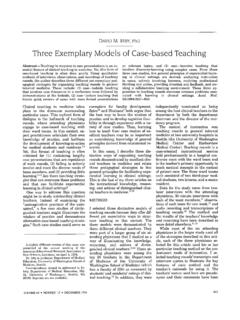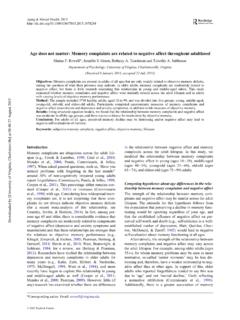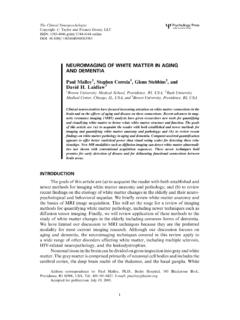Transcription of Bergson s Matter and Memory and Modern Selectionist ...
1 BRAIN AND COGNITION 30, 215 231 (1996). ARTICLE NO. 0014. Bergson 's Matter and Memory '' and Modern Selectionist theories of Memory PATRICK MCNAMARA. Vision House, Tewksbury, Massachusetts Bergson 's reflections (in Matter and Memory , 1896) on Memory anticipated de- velopment of Modern Selectionist theories of Memory . Selectionist models offer new and potentially useful approaches to a theory of remembering. On the model of natural selection, these Selectionist theories require at least two processing compo- nents: a device which generates a range of Memory representations and a selection process which preserves a subset of those representations. Bergson shows how the subjective experience of remembering might be understood within a Selectionist framework.
2 1996 Academic Press, Inc. INTRODUCTION. Henri Bergson (1859 1941) was one of France's most prominent turn- of-the-century philosophers interested in problems of psychology. The range of his psychological interests was astonishing and included consciousness, perception, habits, Memory , the aphasias, dreams, laughter, intuition, time perception, brain functions, multiple personality disorder, the deja vu experi- ence, and much else besides. He was one of the first philosophers (indeed one of the first scholars) to use data from neuropsychological dissociations to illuminate problems of cognition. In this paper I want to discuss some of the themes Bergson explored in one of his earliest and greatest works: Matter and Memory (originally pub- lished as Matie`re et me moire: Essai sur la relation du corps avec l'e sprit,''.)
3 Paris: F. Alcan, 1896). Although Bergson 's major concern in that work was to develop a solution to the mind body problem, he also apparently felt obliged to develop a detailed theory of Memory . I hope to show that Berg- son's Memory theory is Selectionist '' or Darwinian in character and that it compares well with Modern Selectionist theories of Memory and learn- ing'' such as those proposed by Young (1979), Edelman (1987), Changeux and Dehaene (1989), and others. Bergson 's work anticipated these Modern The author thanks David Price, Lyn Frazier, and David Kemmerer for comments on earlier drafts of this paper. Address reprint requests to Patrick McNamara, , Vision House, 460. East Street, Tewksbury, MA 01876. 215. 0278-2626/96 $ Copyright 1996 by Academic Press, Inc.
4 All rights of reproduction in any form reserved. 216 PATRICK MCNAMARA. approaches to Memory by almost a century. I also hope to convince Modern students of cognition that Selectionist models might be usefully applied to problems of Memory . While other investigators in the cognitive sciences have successfully used Selectionist approaches to illuminate problems in their specific areas ( , on language: Piatelli-Palmarini, 1989; Chomsky, 1988; conceptual and cog- nitive development: see papers in Mehler & Fox, 1985; color vision: Varela, Thompson, & Rosch, 1992; perception: Shepard, 1984; creativity: Campbell, 1960; theory and epistemology: Popper, 1963; social exchange/reasoning: Cosmides, 1989), cognitive Memory researchers (with the exception of Edel- man) have not.
5 It is, of course, an open question as to whether Selectionist approaches will illuminate anything in the area of cognitive Memory theory. There are several reasons, however, to think that they might illuminate prob- lems in Memory (see below). The point is that they have not yet been tried. Bergson 's work might be helpful to those interested in applying Selectionist ideas to Memory phenomena. Selectionist theories Selectionist models require at least two distinct processes: a generator of variation that produces an array of elements or traits which become the raw material for the selection process, and a selection process (Changeux & De- haene, 1989), which acts to reduce the number of elements in the initial array (Ward, 1989; Plotkin, 1994).
6 In general, the elements selected are those that happen by chance to be useful in some way for the organism undergoing selection. Some theorists ( Young, 1979) would add an amplification pro- cess which spreads effects of selection through the system. Selection also requires that the elements ( , traits) subject to selection must exhibit some degree of consistency through time. If the elements changed randomly and continuously, it would not be possible for the selector'' to act selectively with respect to a given trait (Ward, 1989). The main effect of selection, then, is to alter the observed frequency distribution of traits represented in the initial array by reducing the number of elements in the initial array. Just as Nature in its profligacy generates a huge number of forms or possi- bilities on the chance that some range of these will match a given ecological niche, so too, the generator in a Memory system would produce a range of forms (memories).
7 Some few of these Memory images would, by chance, match some informational features of the external world or from another cognitive system. If other branches of biology are any guide ( , the im- mune system, see Jerne, 1985), we would expect the number of generated forms to be quite large. In the immune system, for example, there is a vast repertoire of molecules which can produce antibodies that can recognize any possible antigen. Antibodies are manufactured by lymphocytes which circu- late through the blood, bone marrow, immune system glands ( , lymph Bergson AND Memory THEORY 217. nodes and thymus), and other sites. There are approximately 1012 lympho- cytes. B-lymphocytes produce the antibody molecules, while T-lymphocytes regulate production of antibodies.
8 Human B-lymphocytes are capable of pro- ducing over 10 million different varieties of antibodies. This repertoire of antibodies can recognize and respond to any molecule existing in the world (antigens). An antigen binds to or selects certain of these antibodies which are then amplified by a process of clonal multiplication. Once the antigen is bound several varieties of immune system molecules can then be activated to destroy the invader. Thus, the immune system is characterized by an initial diversity (a repertoire of antibody molecules) that can meet (via selection and amplification) any challenge. With respect to the Memory system (and other cognitive systems), some authors ( , Piatelli-Palmarini, 1989; Changeux & Dehaene, 1989) have suggested that combinatorial mechanisms might produce the initial diversity.
9 If we assume ( Bergson actually argued against localization of memories in the brain) that the central nervous system is the device that generates memo- ries, then CNS structure would impose constraints on the actual number of possibilities or forms produced by the generator. Nevertheless, the numbers are astronomical. The basic fact is that the nervous system contains a vast number of nerve cells and fibers, perhaps ten thousand million neurons in the human cerebral cortex and at least ten thousand million in the cerebellum. Moreover, each cell makes a great number of connections: there are up to 60,000 synaptic points on a large cortical neuron .. (Young, 1979, p. 802). Thus, the generative power of the nervous system is clearly enormous. There are several reasons to think that Selectionist models might be useful for Memory theory.
10 Selection involves a reduction in number of states, traits, entities, or elements from an initial plenitude of possible alternatives. As Ward (1989) has pointed out in his discussion of the similarities between selection and information theory, the information content of a signal from a given source depends on the extent to which that signal represents a reduc- tion of the total array of signals possible, in principle, from that source. Infor- mation transmission, in other words, involves a process of noise reduction and signal enhancement. Because selection effects a similar reduction in the number of possible alternatives, it necessarily produces information content in the organism undergoing the selective action one trait is preserved while others are not.



















